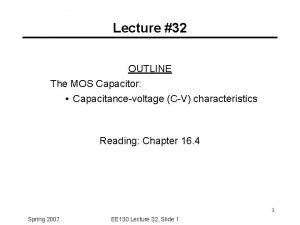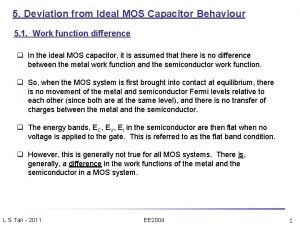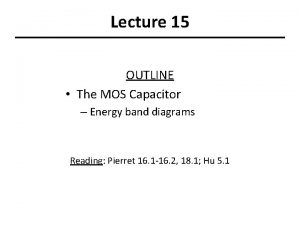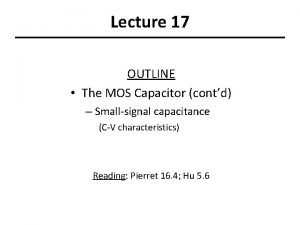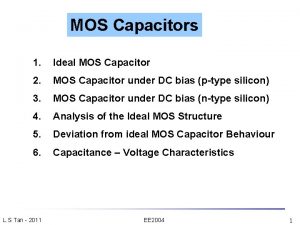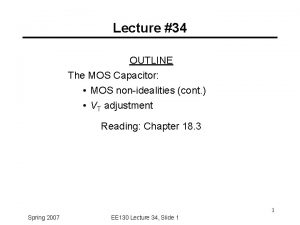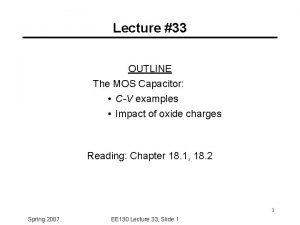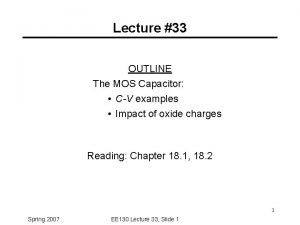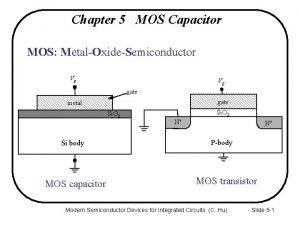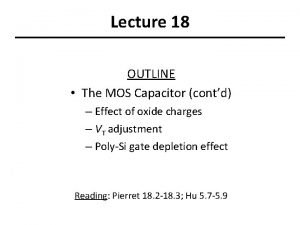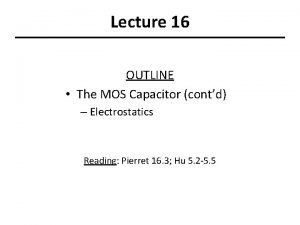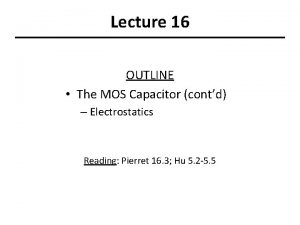Lecture 33 OUTLINE The MOS Capacitor CV examples











- Slides: 11

Lecture #33 OUTLINE The MOS Capacitor: • C-V examples • Impact of oxide charges Reading: Chapter 18. 1, 18. 2 1 Spring 2007 EE 130 Lecture 33, Slide 1

Examples: C-V Characteristics C QS Cox HF-Capacitor VFB VT VG Does the QS or the HF-capacitor C-V characteristic apply? (1) MOS capacitor, f=10 k. Hz. (2) MOS transistor, f=1 MHz. (3) MOS capacitor, slow VG ramp. (4) MOS transistor, slow VG ramp. 2 Spring 2007 EE 130 Lecture 33, Slide 2

Example: Effect of Doping C/Cox 1 VFB VT VG • How would C-V characteristic change if substrate doping NA were increased? – VFB – VT – Cmin 3 Spring 2007 EE 130 Lecture 33, Slide 3

Example: Effect of Oxide Thickness C/Cox 1 VFB VT VG • How would C-V characteristic change if oxide thickness xo were decreased? – VFB – VT – Cmin 4 Spring 2007 EE 130 Lecture 33, Slide 4

Oxide Charges In real MOS devices, there is always some charge in the oxide and at the Si/oxide interface. • In the oxide: – Trapped charge Qot • High-energy electrons and/or holes injected into oxide – Mobile charge QM • Alkali-metal ions, which have sufficient mobility to drift in oxide under an applied electric field • At the interface: – Fixed charge QF • Excess Si (? ) – Trapped charge QIT • Dangling bonds 5 Spring 2007 EE 130 Lecture 33, Slide 5

Effect of Oxide Charges • In general, charges in the oxide cause a shift in the gate voltage required to reach the threshold condition: (x defined to be 0 at metal-oxide interface) • In addition, they may alter the field-effect mobility of mobile carriers (in a MOSFET) due to Coulombic scattering 6 Spring 2007 EE 130 Lecture 33, Slide 6

Fixed Oxide Charge QF M 3. 1 e. V O S q. QF / Cox Ec= EFM |q. VFB | Ev Ec EFS Ev 4. 8 e. V 7 Spring 2007 EE 130 Lecture 33, Slide 7

Parameter Extraction from C-V From a single C-V measurement, we can extract much information about the MOS device. • Suppose we know that the gate-electrode material is heavily doped n-type poly-Si (FM=4. 05 e. V), and that the gate dielectric is Si. O 2 (er=3. 9): – From Cmax = Cox we determine the oxide thickness xo – From Cmin and Cox we determine substrate doping (by iteration) – From substrate doping and Cox we calculate the flat-band capacitance CFB – From the C-V curve, we can find – From FM, FS, Cox, and VFB we can determine Qf 8 Spring 2007 EE 130 Lecture 33, Slide 8

Determination of FM and QF Measure C-V characteristics of capacitors with different oxide thicknesses. Plot VFB as a function of xo: VFB 10 nm 20 nm 30 nm 0 xo – 0. 15 V ´ ´ – 0. 3 V ´ 9 Spring 2007 EE 130 Lecture 33, Slide 9

Mobile Ions • Odd shifts in C-V characteristics were once a mystery: • Source of problem: Mobile charge moving to/away from interface, changing charge centroid 10 Spring 2007 EE 130 Lecture 33, Slide 10

Interface Traps cause “sloppy” C-V and also greatly degrade mobility in channel 11 Spring 2007 EE 130 Lecture 33, Slide 11
 Cv measurement of mos capacitor
Cv measurement of mos capacitor Energy band diagram of mos capacitor
Energy band diagram of mos capacitor Ece 340
Ece 340 Mos
Mos Mos capacitor energy band diagram
Mos capacitor energy band diagram Cv measurement of mos capacitor
Cv measurement of mos capacitor Mos capacitor
Mos capacitor 01:640:244 lecture notes - lecture 15: plat, idah, farad
01:640:244 lecture notes - lecture 15: plat, idah, farad Lecture outline example
Lecture outline example Lecture outline example
Lecture outline example Lecture outline example
Lecture outline example Lecture outline meaning
Lecture outline meaning
